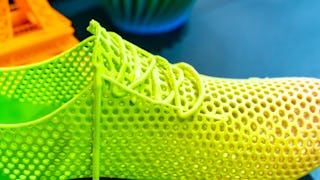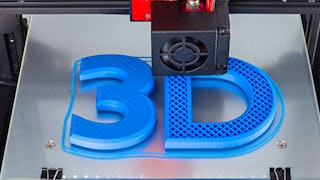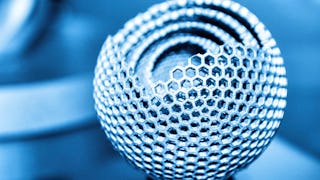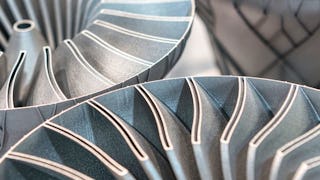Additive Manufacturing, popularly known as 3D Printing, is one of the digital manufacturing processes and a key enabler of Industry 4.0. This course will introduce the fundamental concepts of different Additive Manufacturing processes. It involves a detailed discussion on the working principles, classifications, process parameters, system architecture, etc.


您将获得的技能
要了解的详细信息

添加到您的领英档案
29 项作业
了解顶级公司的员工如何掌握热门技能

积累特定领域的专业知识
- 向行业专家学习新概念
- 获得对主题或工具的基础理解
- 通过实践项目培养工作相关技能
- 获得可共享的职业证书

该课程共有7个模块
Additive Manufacturing popularly known as 3D Printing is one of the digital manufacturing processes and a key enabler of Industry 4.0. This course will introduce the fundamental concepts of different Additive Manufacturing processes. It involves a detailed discussion on the working principles, classifications, process parameters, system architecture, etc.
涵盖的内容
3篇阅读材料1个讨论话题
Additive Manufacturing popularly known as 3D Printing is one of the digital manufacturing processes and a key enabler of Industry 4.0. It is a process of layer-by-layer deposition of material and realizing a 3D object. It can be termed several other names also, based on its application to the manufacturing community. Why additive manufacturing is referred to by different terminology has been discussed in this module. What are the unique capabilities possessed by additive manufacturing and how are they useful in real-life applications have been discussed in this module. Freedom of design, mass customization, waste minimization, and the ability to manufacture complex structures, as well as fast prototyping, are the main benefits of additive manufacturing. In particular, there are some revolutionary applications of AM in biomedical, aerospace, buildings, and protective structures that are discussed in this section. Moreover, based on what criteria the ASTM F42 committee had classified, the AM process is also covered in this module.
涵盖的内容
16个视频10篇阅读材料5个作业
Most liquid-based additive manufacturing systems build parts in a vat of photo-curable liquid resin, an organic resin that cures or solidifies under the effect of exposure to light, usually in the UV range. The light cures the resin near the surface, forming a thin hardened layer. Once the complete layer of the part is formed, it is lowered by an elevation control system to allow the next layer of resin to be coated and similarly formed over it. This continues until the entire part is completed. The vat can then be drained and the part removed for further processing, if necessary. There are variations to this technique by the various vendors and they are dependent on the type of light or laser, method of scanning or exposure, type of liquid resin, and type of elevation and optical system used. Different technologies have been developed based on liquid AM by changing its sub-systems, those commercially available tech parts are discussed in this module. Moreover, a deep insight has been made in water based rapid freezing technology and its working conditions.
涵盖的内容
27个视频14篇阅读材料6个作业
Sheet based additive manufacturing is also known as laminated object manufacturing or sheet lamination, shares similar fabrication principles with other AM processes. But instead of using liquid or powder or wire as feedstock, sheet lamination uses foil to make an object. This AM technique was first demonstrated by Helisys Inc. Different materials can be processed using this sheet lamination technique like paper, composite, and selective metal lamination. In the paper-based lamination, papers/foils are glued together layer by layer and precisely cut to the designed geometry to make the final object. Potentially any sheet material that can be precisely cut using cutting tools like laser, mechanical cutter, etc., and the same can be bonded using adhesive, soldering, brazing, welding, etc., for part construction. The paper thicknesses usually range from 0.07 to 0.2 mm. Composite lamination has a similar principle, but some reinforcement can be added to the buck material to improve the strength of the fabricated part. Rather than adding glue to all over the layer, a binder can be selectively applied in certain locations of that layer to fabricate the part. Different sheet lamination processes had demonstrated in past years which would be discussed in details in this module.
涵盖的内容
14个视频6篇阅读材料5个作业
This module deals with different AM processes which uses wire as a feedstock material to construct a 3D object. The classifications have been made based on various sub-systems used in wire based AM technology. There are multiple options available as wire material like plastic, wax, composites, and metals; each of the material incorporated in part fabrication required different set of machine arrangement. All commercially available wire based AM process have been covered in this module. Moreover, the function of essential accessories and influence of design parameters are also discussed under individual systems. The most important factors in metal wire based AM technology are omnidirectionality, geometric processing, single bead, multi-bead disposition strategy. All mentioned factors need to be thoroughly studied and planned according to machine environment before starting the material deposition or part fabrication.
涵盖的内容
25个视频13篇阅读材料6个作业
This module deals with powder based additive manufacturing systems or direct energy deposition. Like wire based AM processes here metallic or ceramic powders are used as a feed stock material to realize an object. There are two types of material handling mechanism involved, one is powder-feed on contentious or pulse setting mode and another is powder-bed. Both approaches have its own benefits and limitations. Moreover, there are processes like selective laser sintering (SLS) and selective laser melting (SLM) in which powder gets partially or completely melted and fused together and bonding takes place between powder molecules. The binder-jetting is also a suitable approach for powder based AM. However, powder based AM systems have different set of subsystems as compared to other AM process. These sub-systems are powder metering, conveyance, and delivery, mainly involved in powder feed unit. Different commercially available powder based AM systems has been discussed with proper video demonstration.
涵盖的内容
22个视频9篇阅读材料6个作业
涵盖的内容
1篇阅读材料1个作业
获得职业证书
将此证书添加到您的 LinkedIn 个人资料、简历或履历中。在社交媒体和绩效考核中分享。
位教师

从 Mechanical Engineering 浏览更多内容
 状态:免费试用
状态:免费试用Arizona State University
 状态:免费试用
状态:免费试用University of Michigan
 状态:免费试用
状态:免费试用Arizona State University
 状态:免费试用
状态:免费试用Arizona State University
人们为什么选择 Coursera 来帮助自己实现职业发展




常见问题
To access the course materials, assignments and to earn a Certificate, you will need to purchase the Certificate experience when you enroll in a course. You can try a Free Trial instead, or apply for Financial Aid. The course may offer 'Full Course, No Certificate' instead. This option lets you see all course materials, submit required assessments, and get a final grade. This also means that you will not be able to purchase a Certificate experience.
When you enroll in the course, you get access to all of the courses in the Specialization, and you earn a certificate when you complete the work. Your electronic Certificate will be added to your Accomplishments page - from there, you can print your Certificate or add it to your LinkedIn profile.
Yes. In select learning programs, you can apply for financial aid or a scholarship if you can’t afford the enrollment fee. If fin aid or scholarship is available for your learning program selection, you’ll find a link to apply on the description page.
更多问题
提供助学金,



